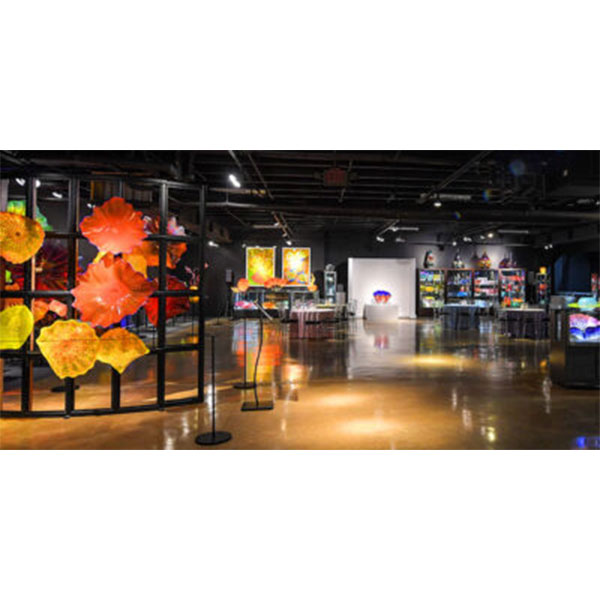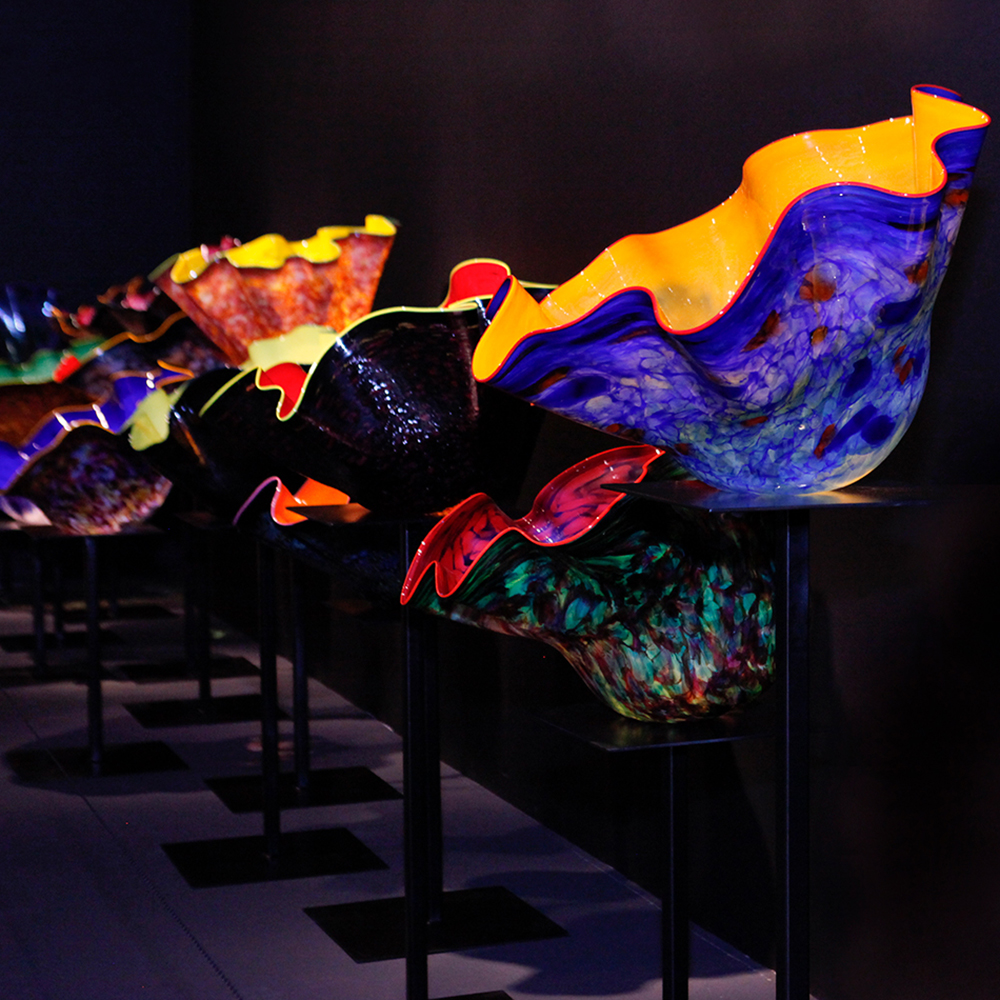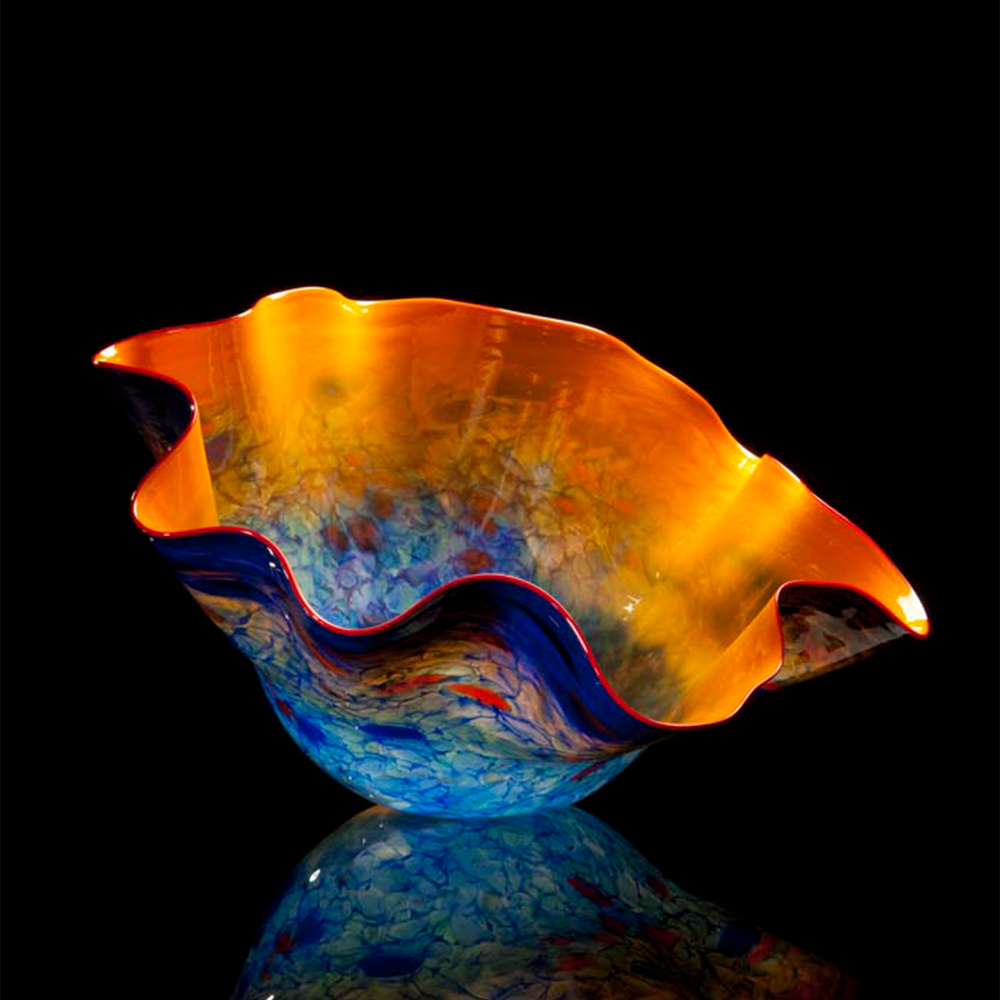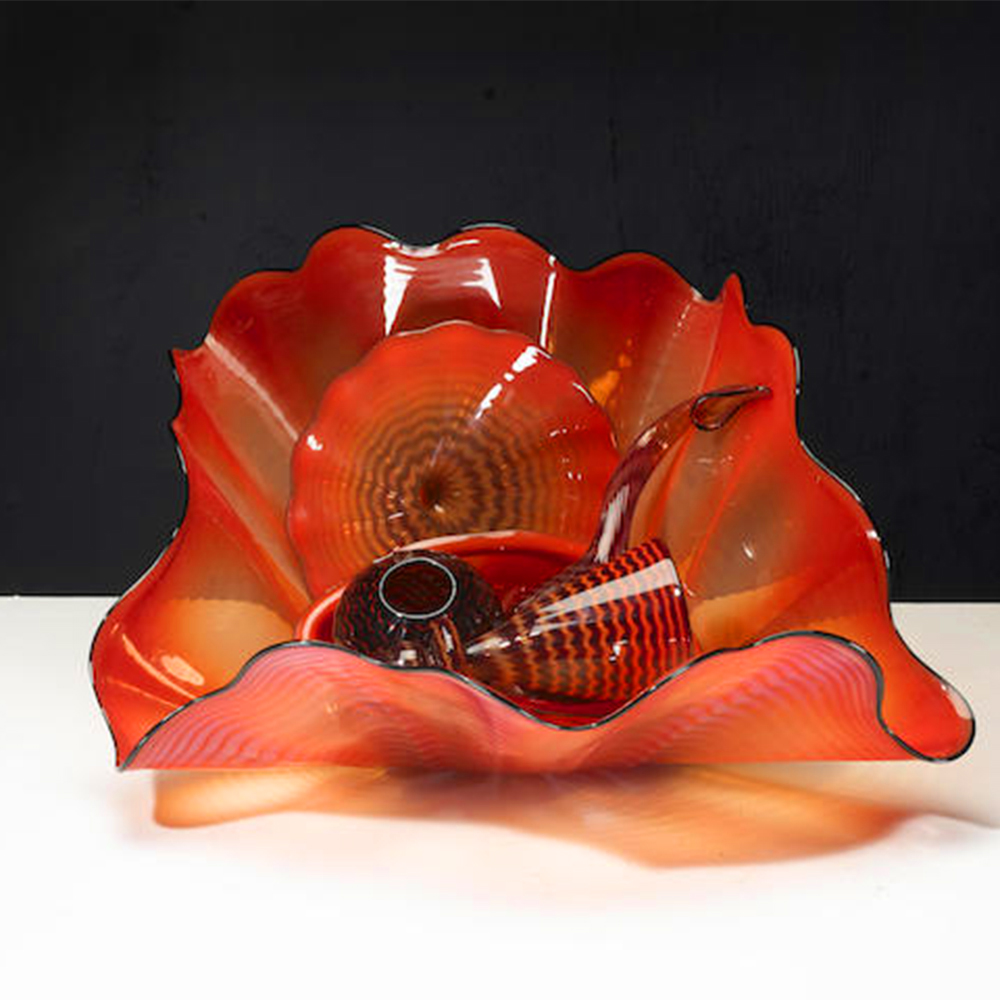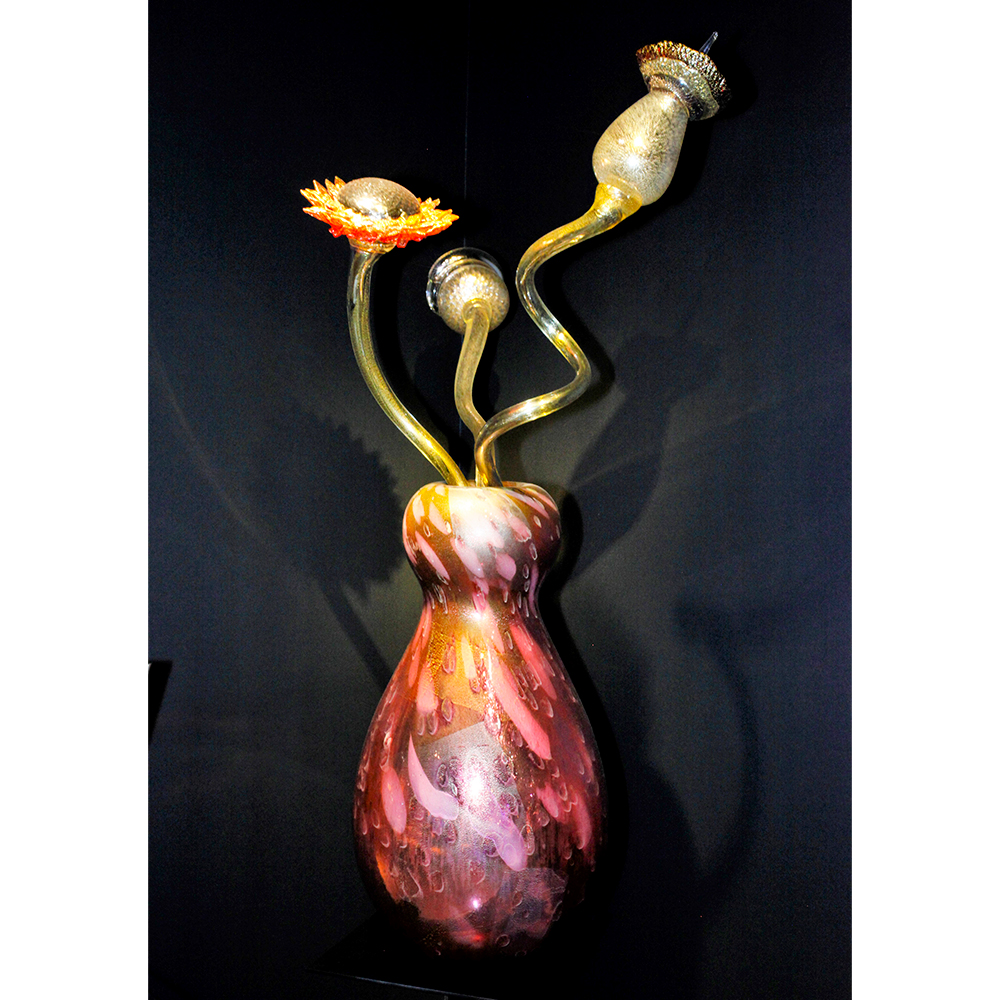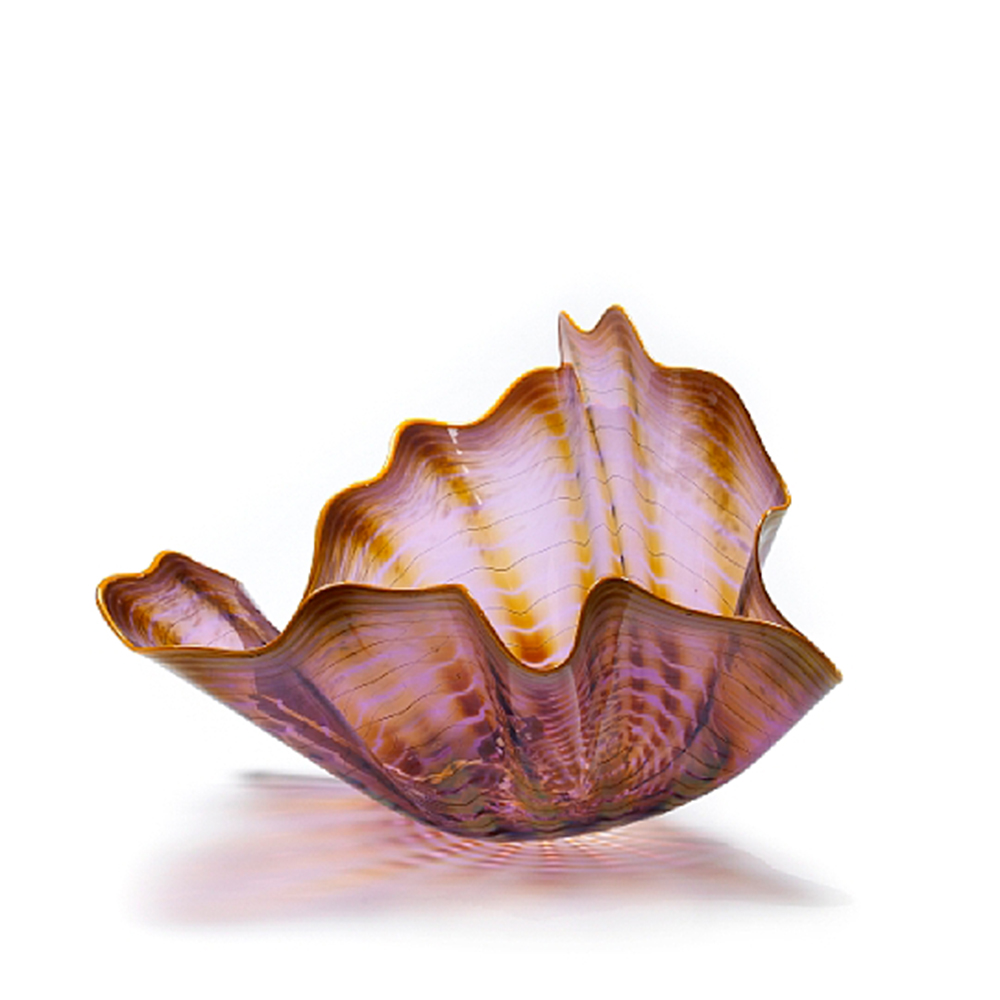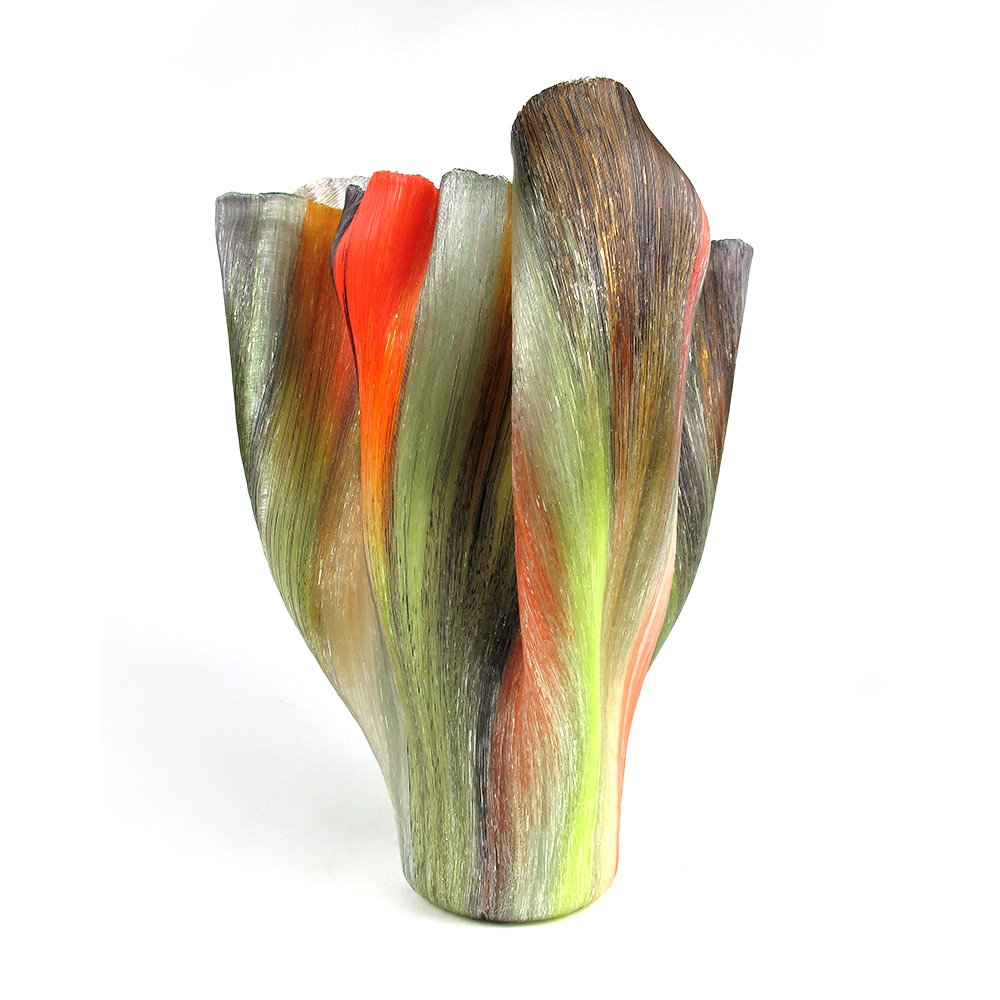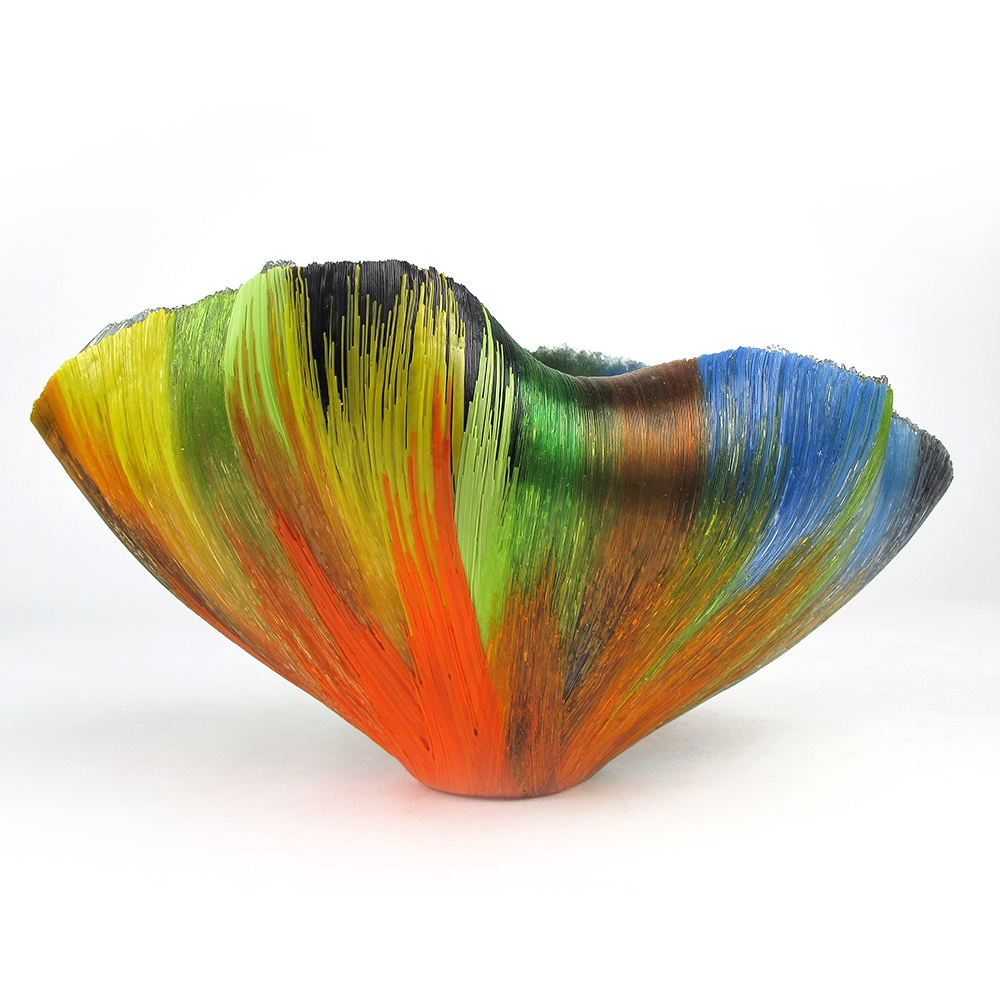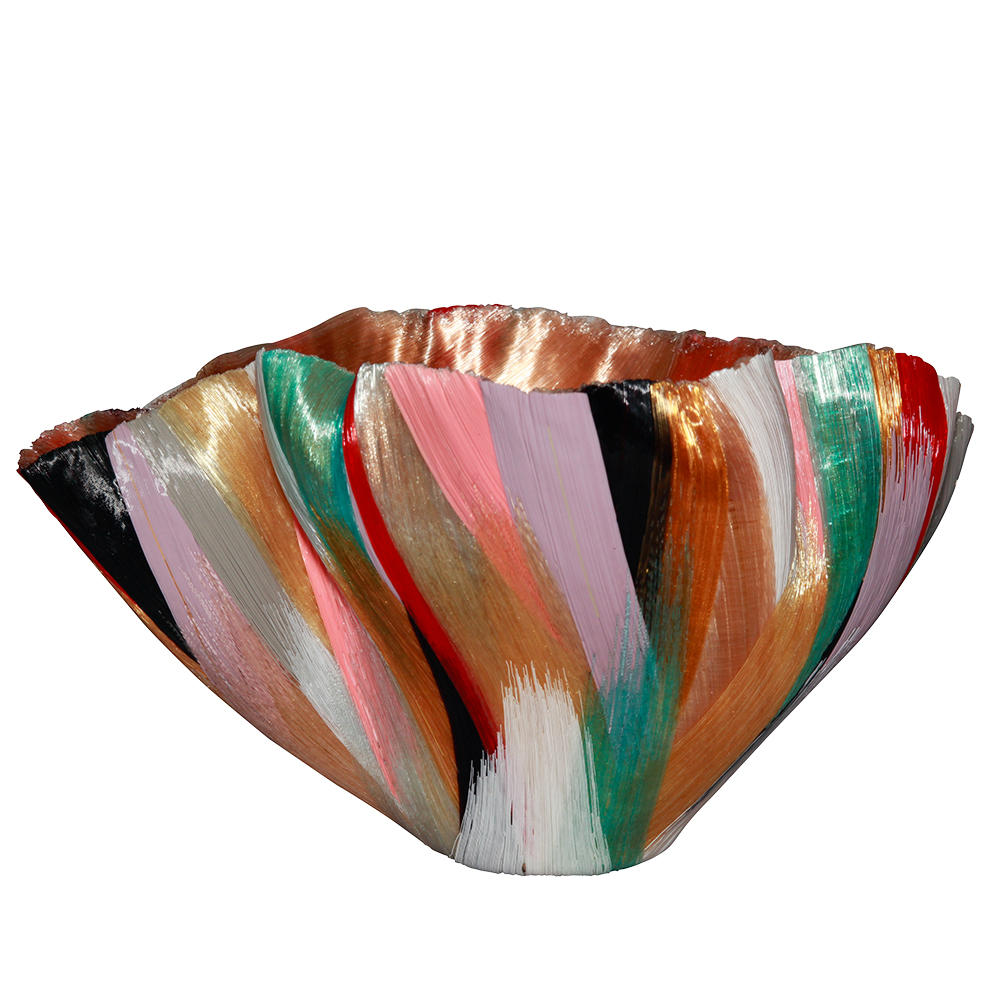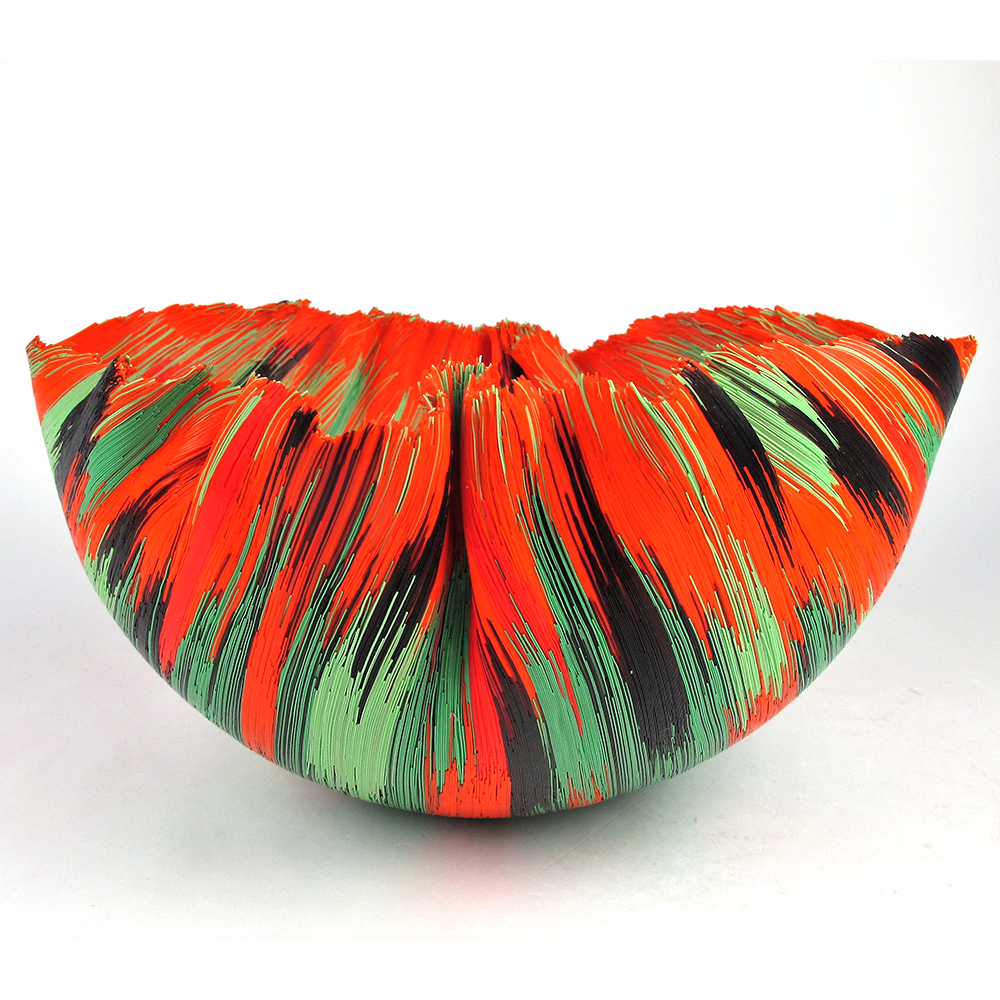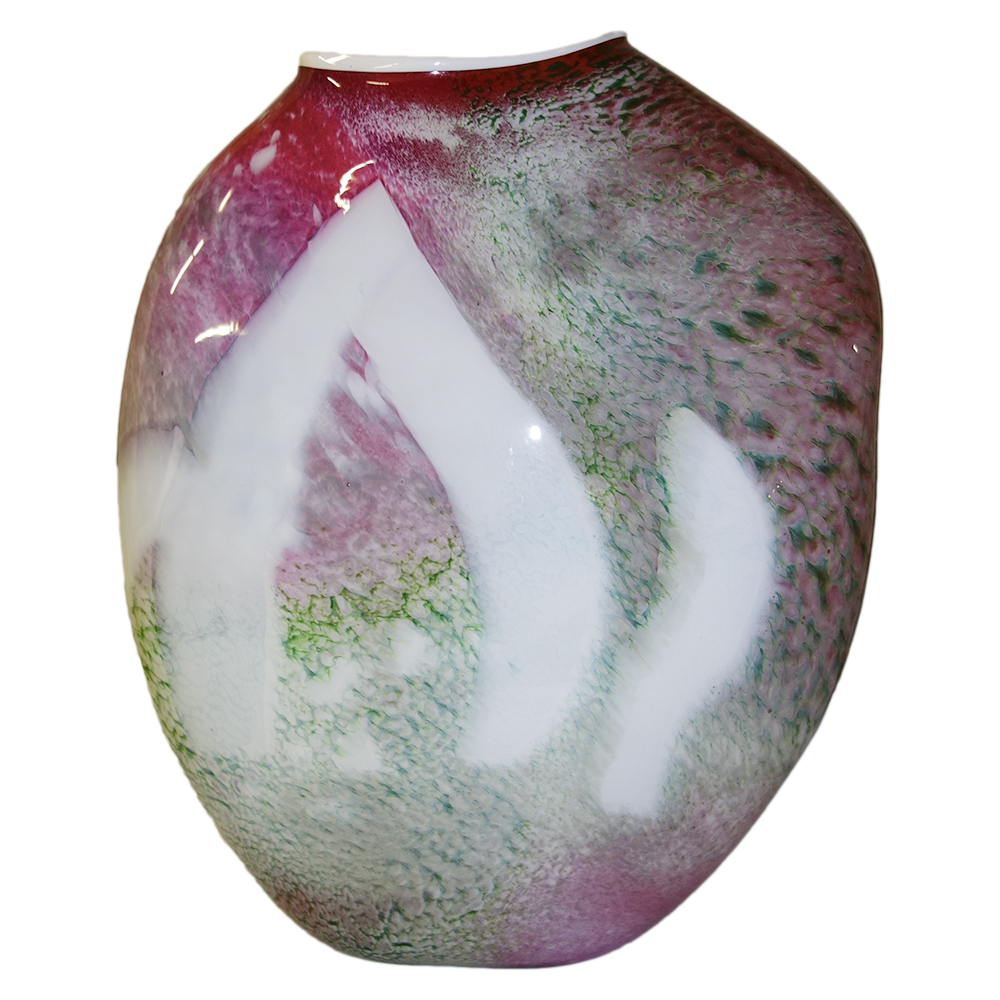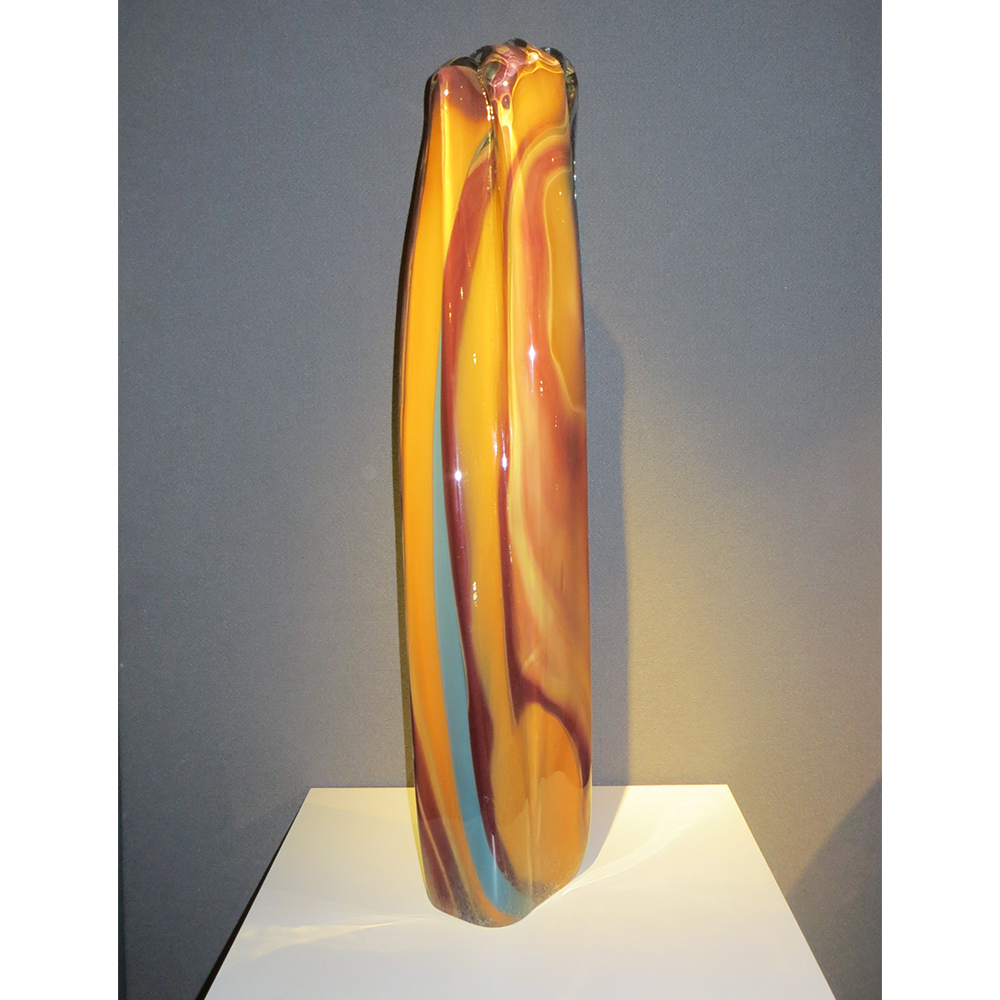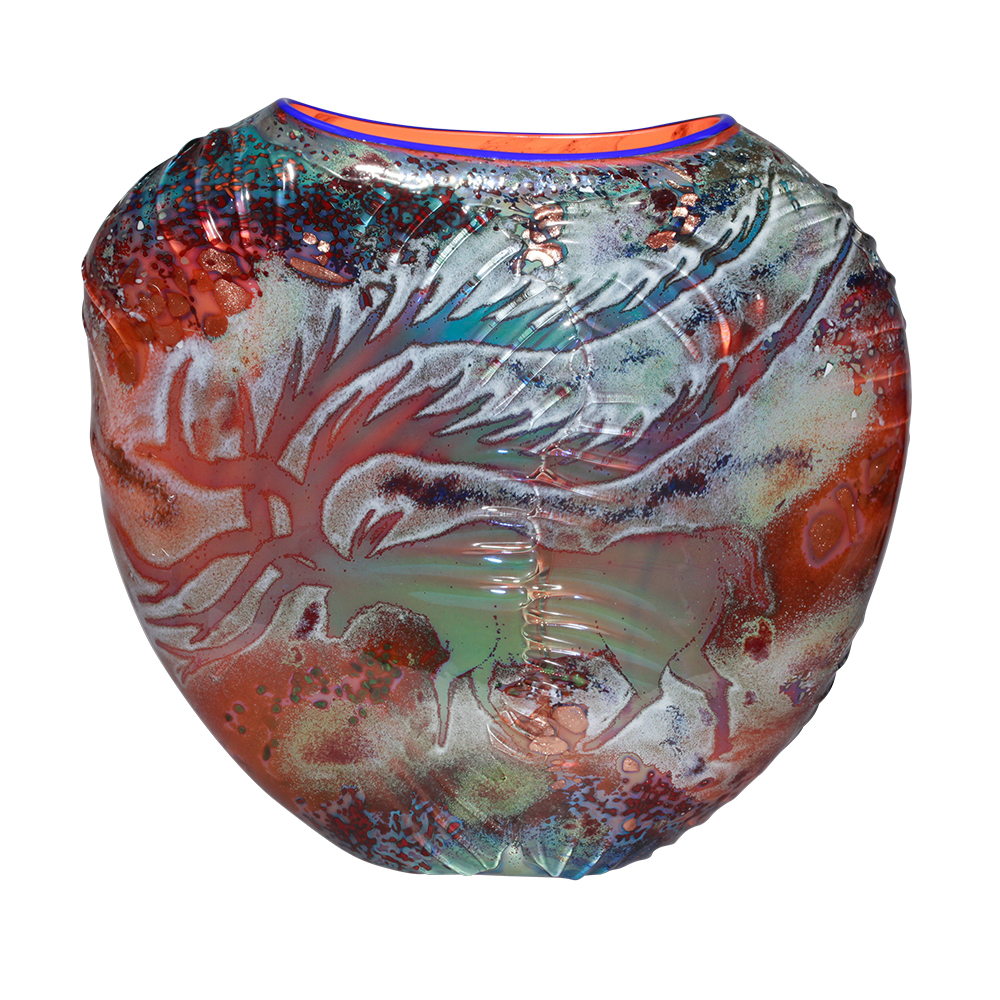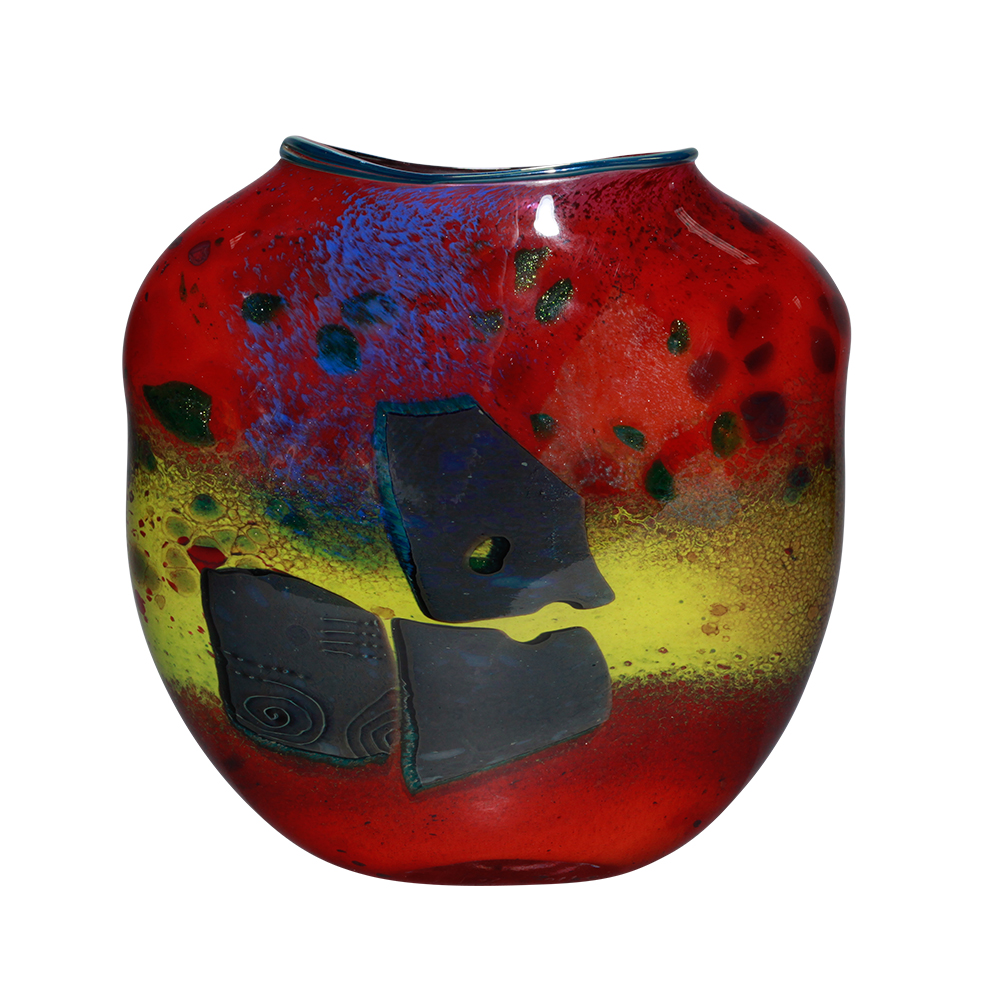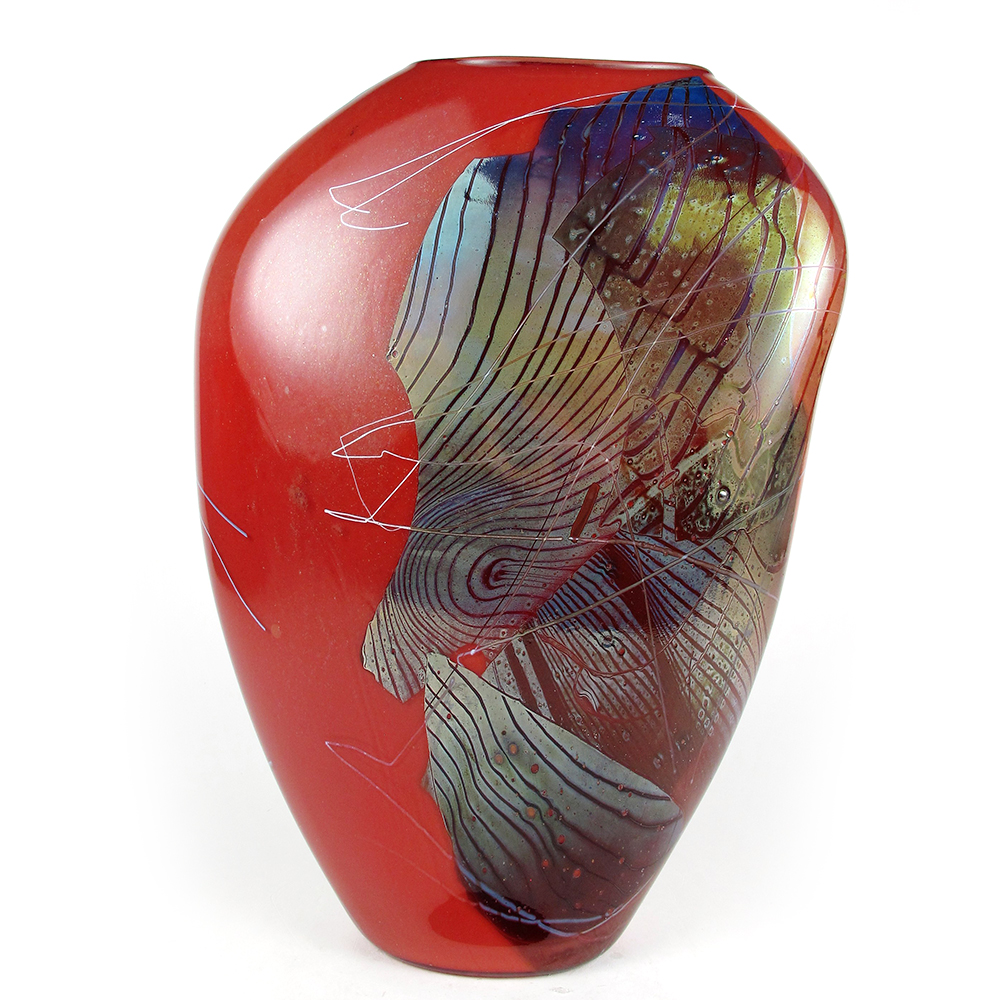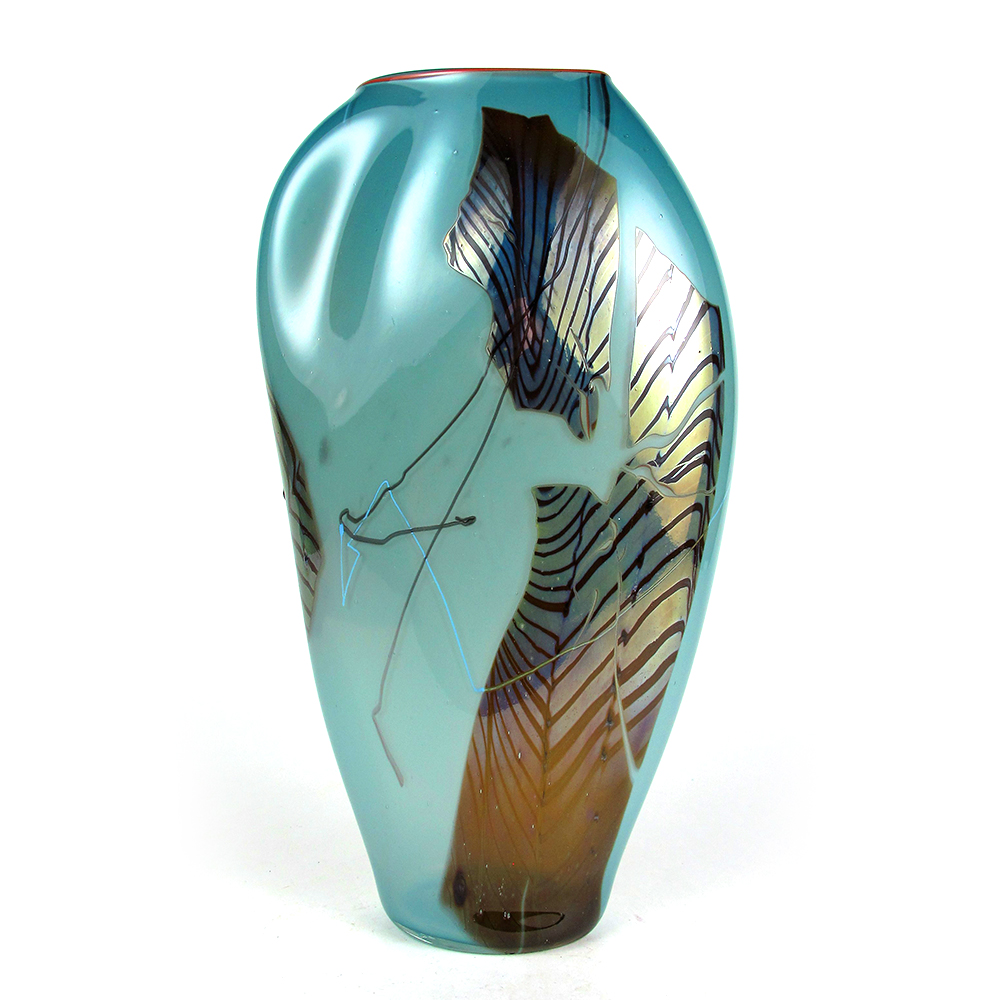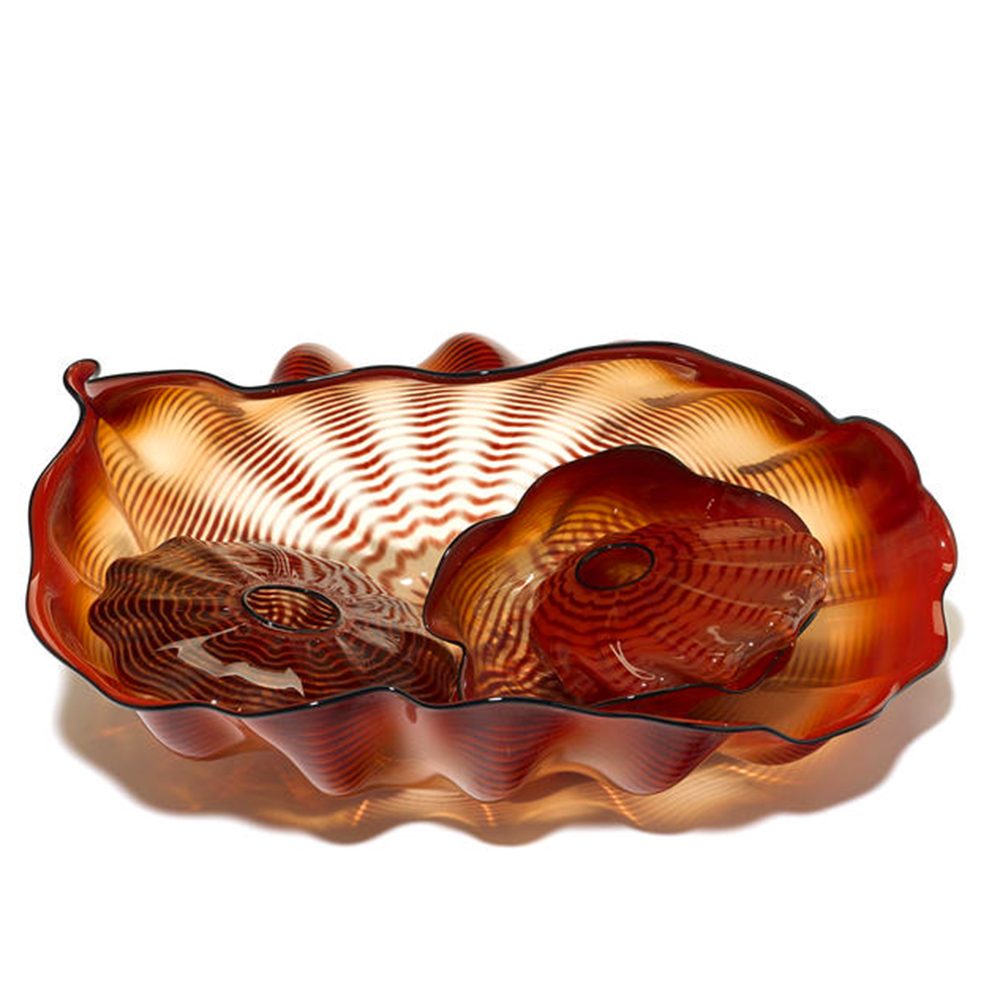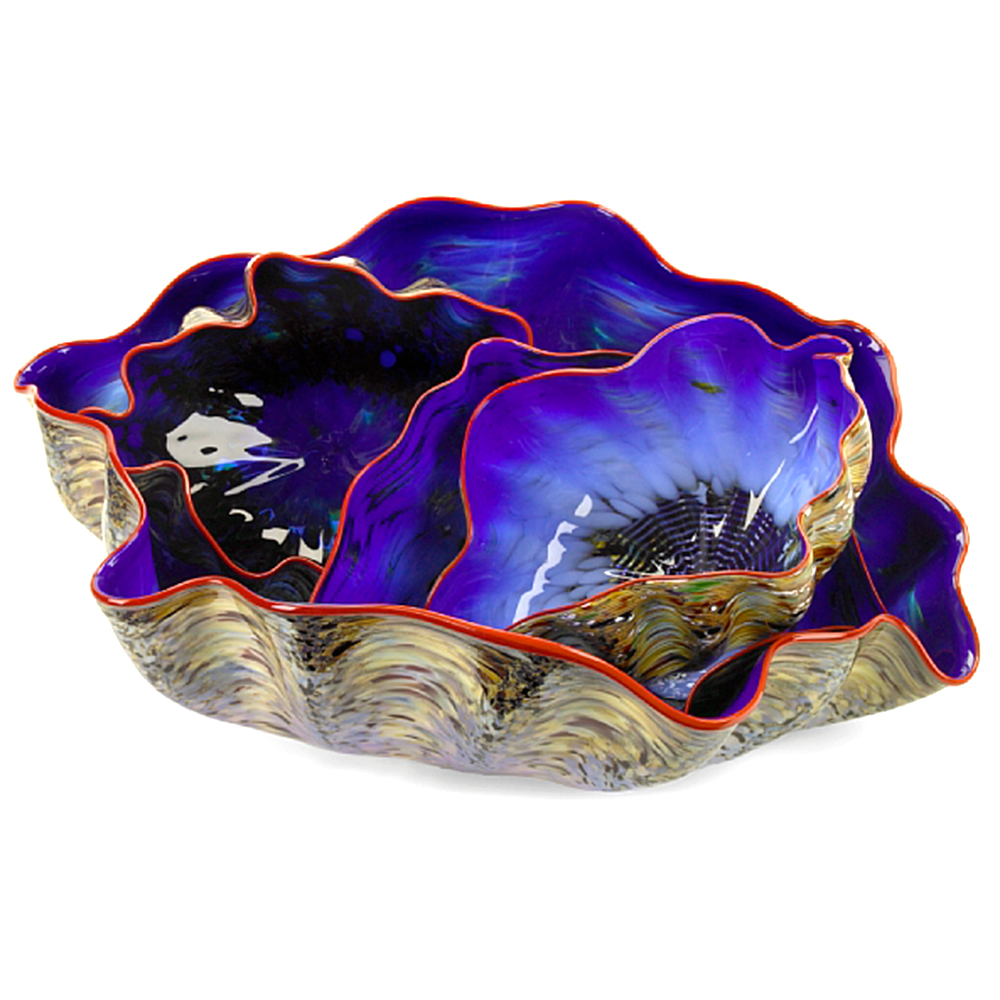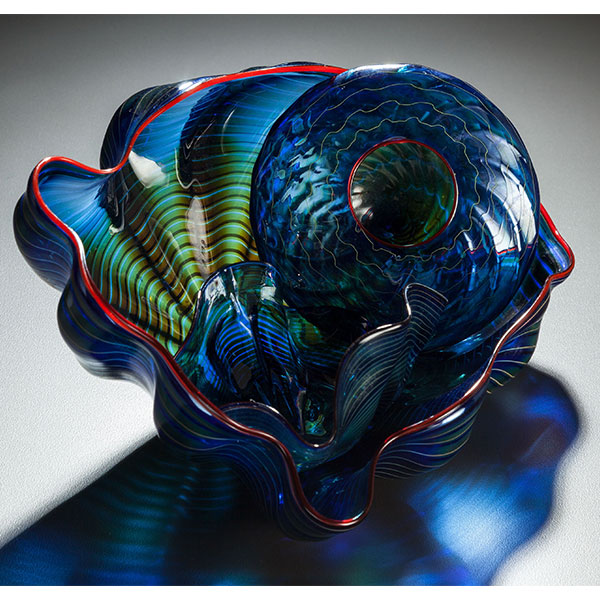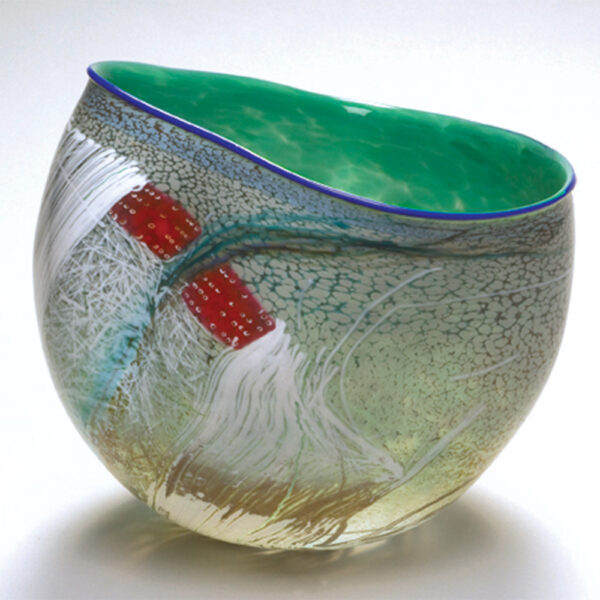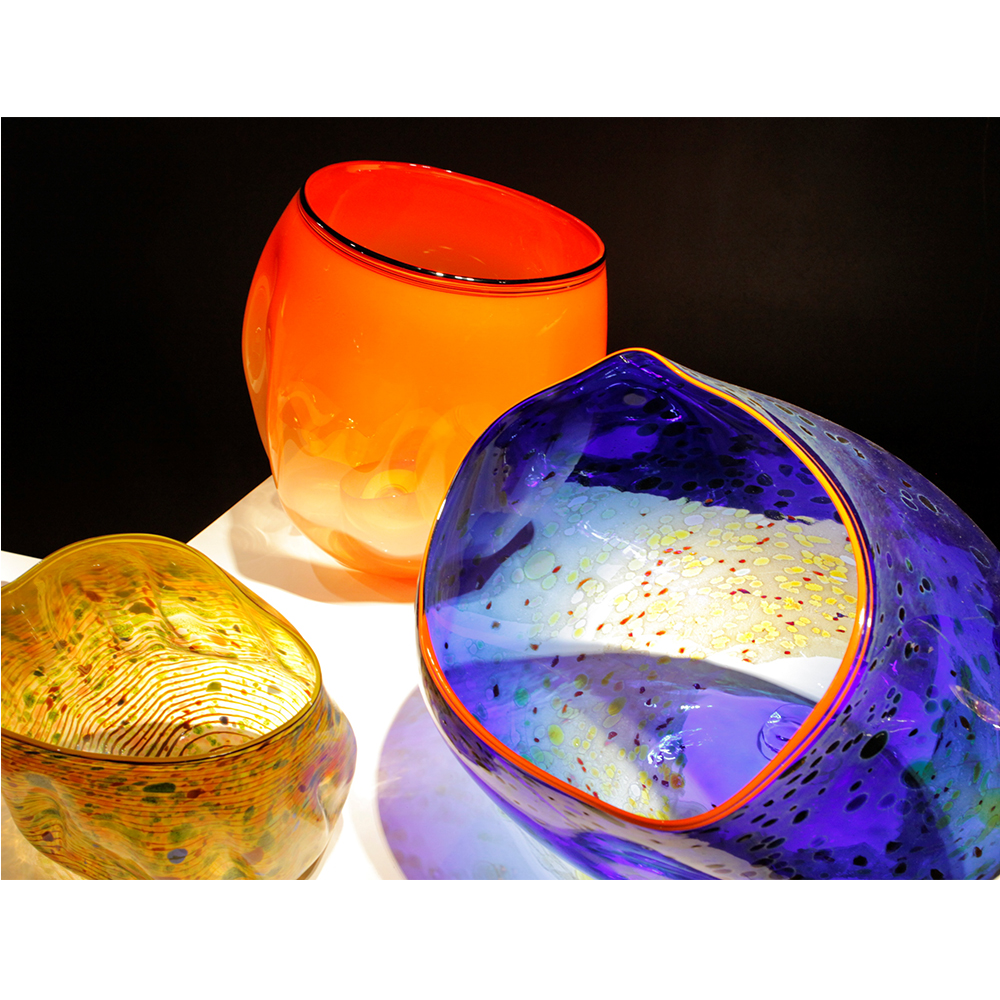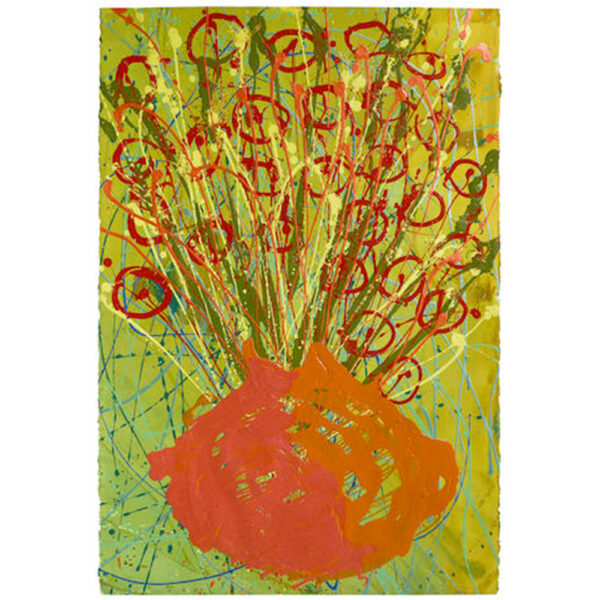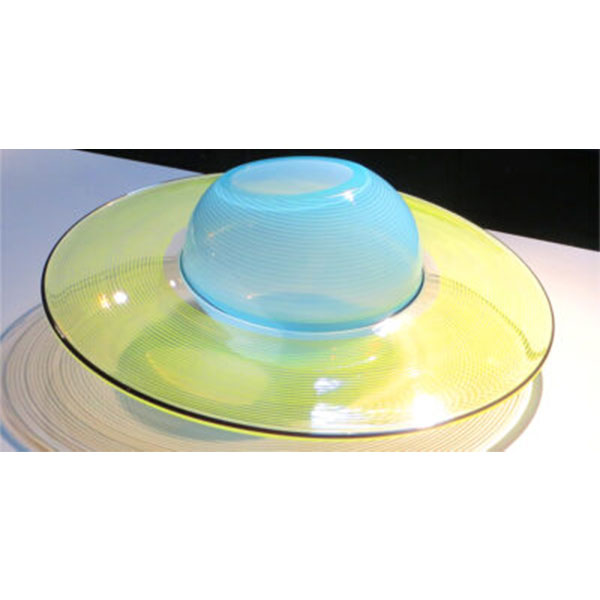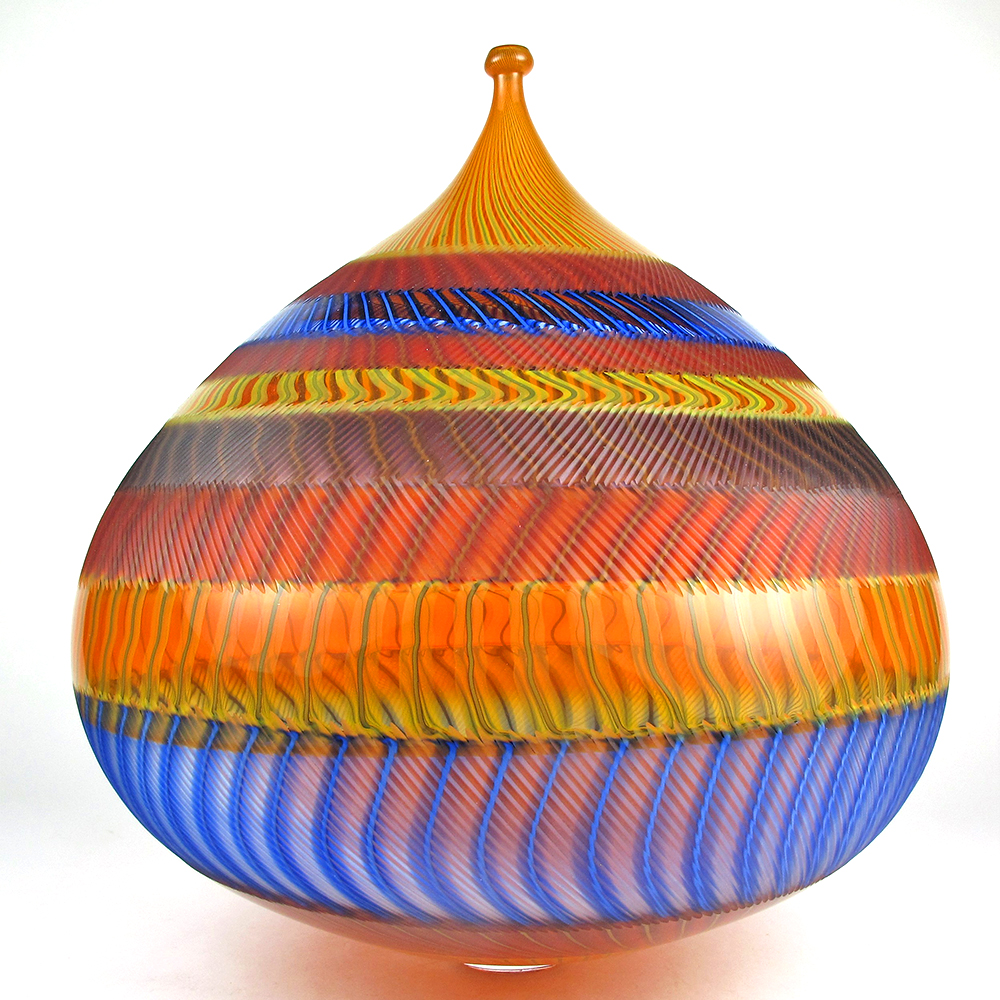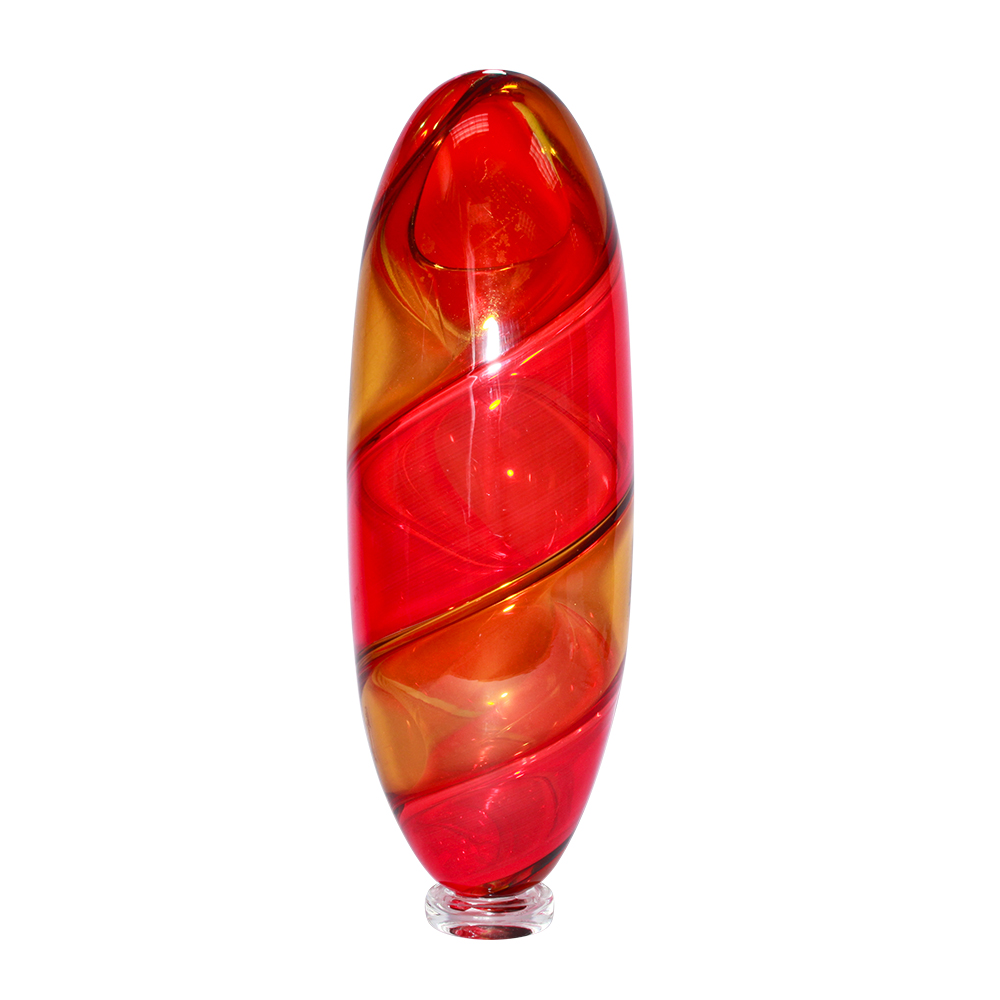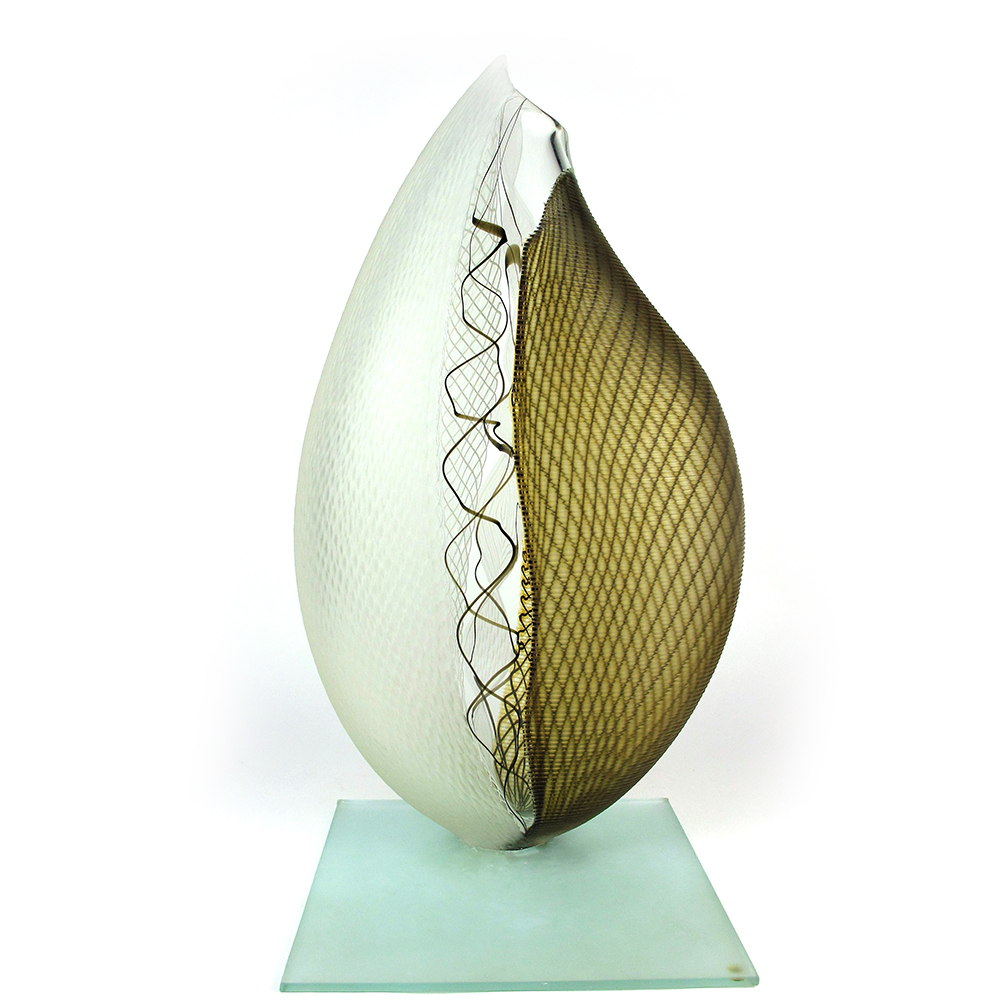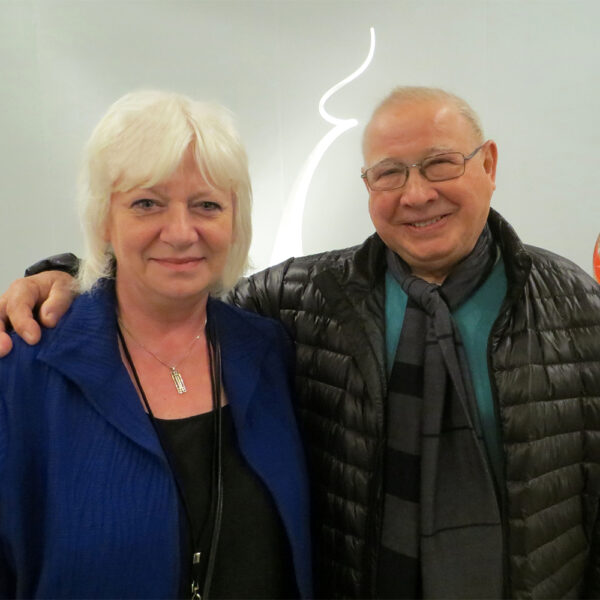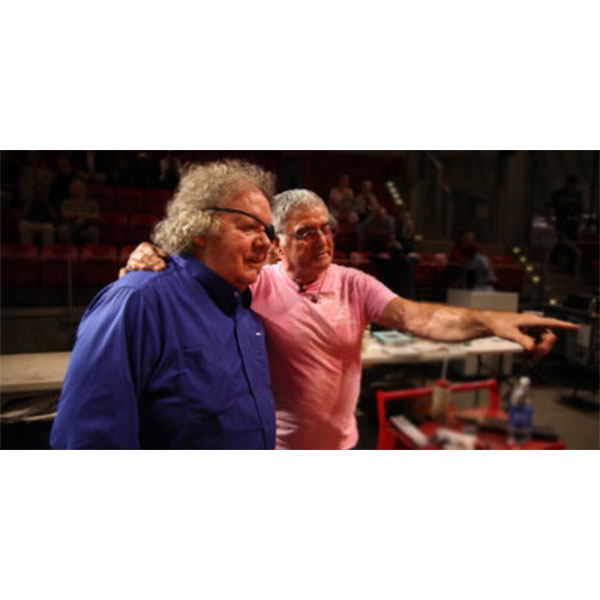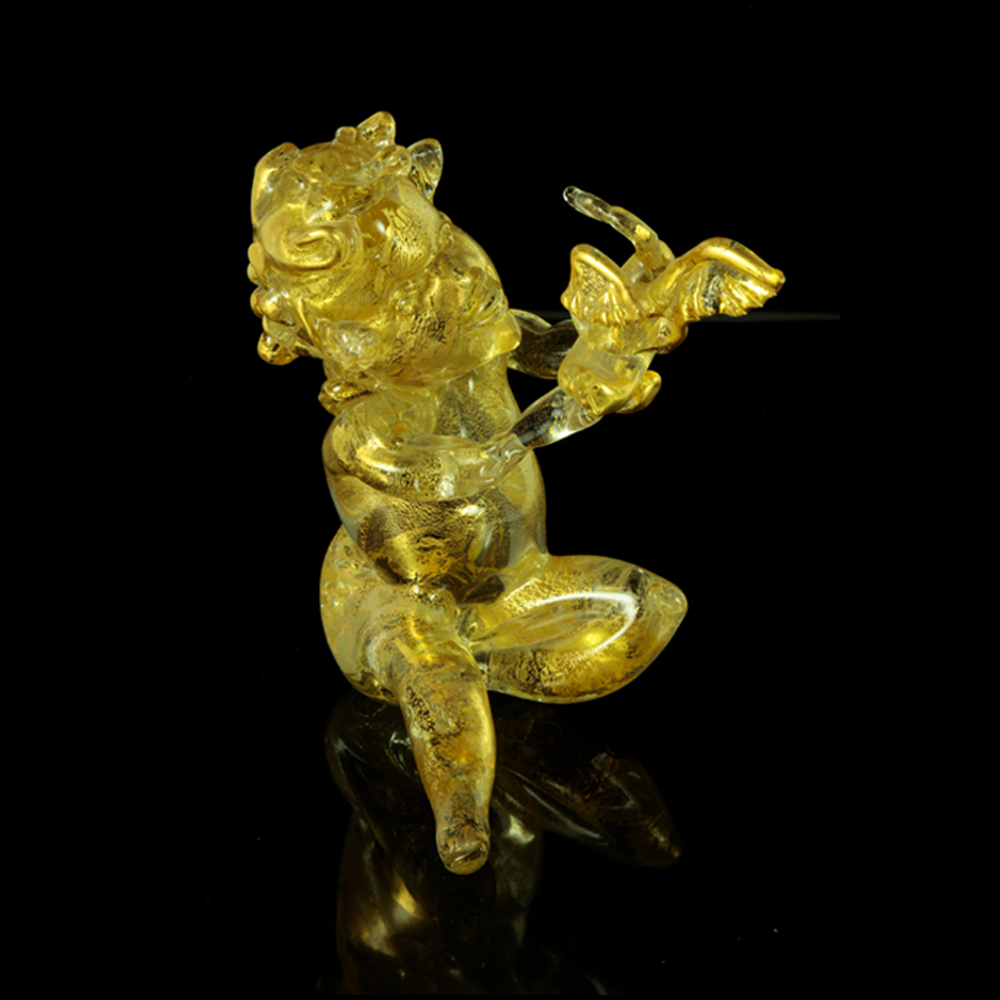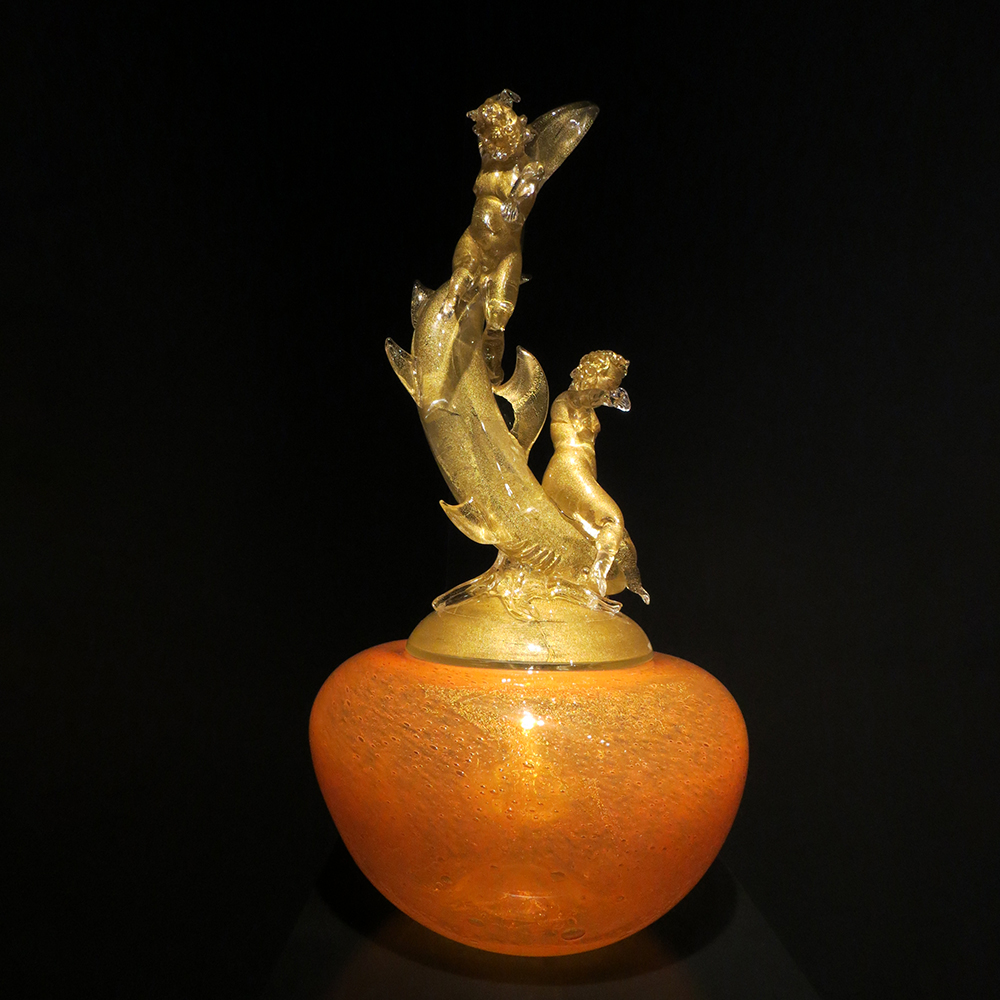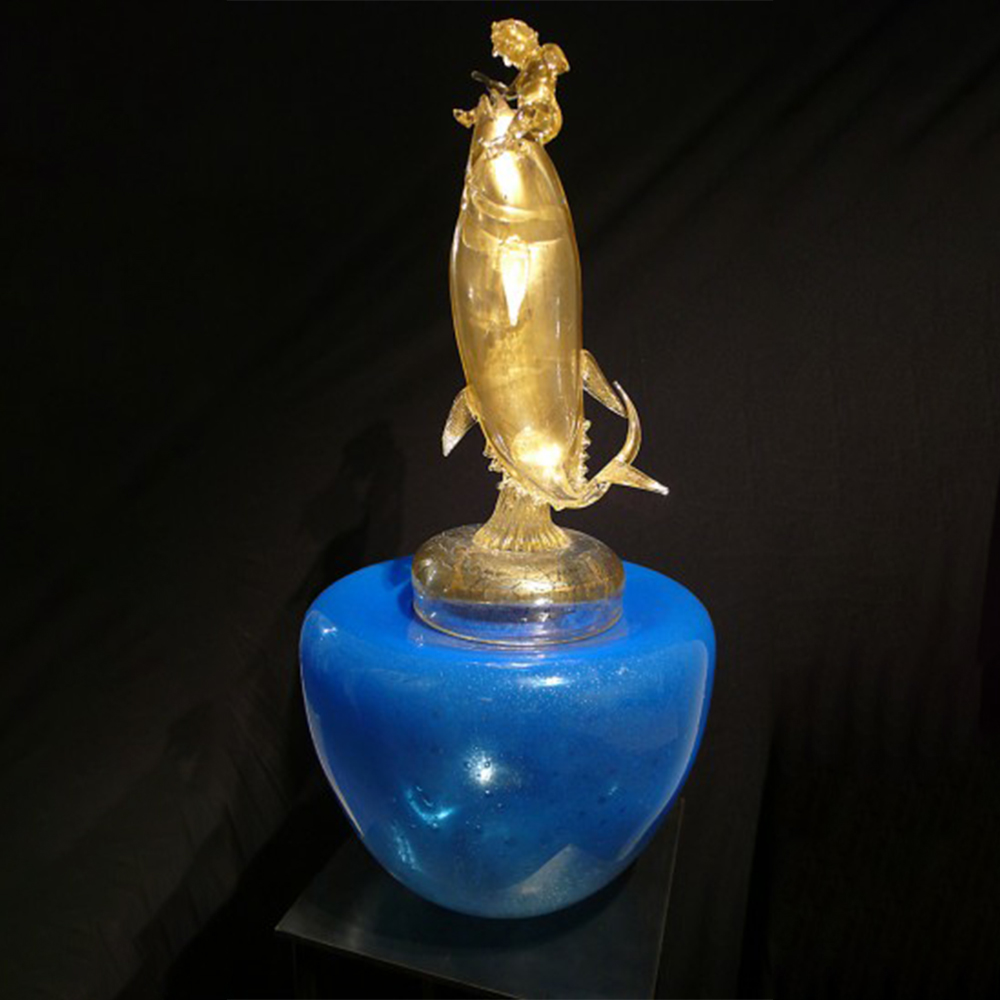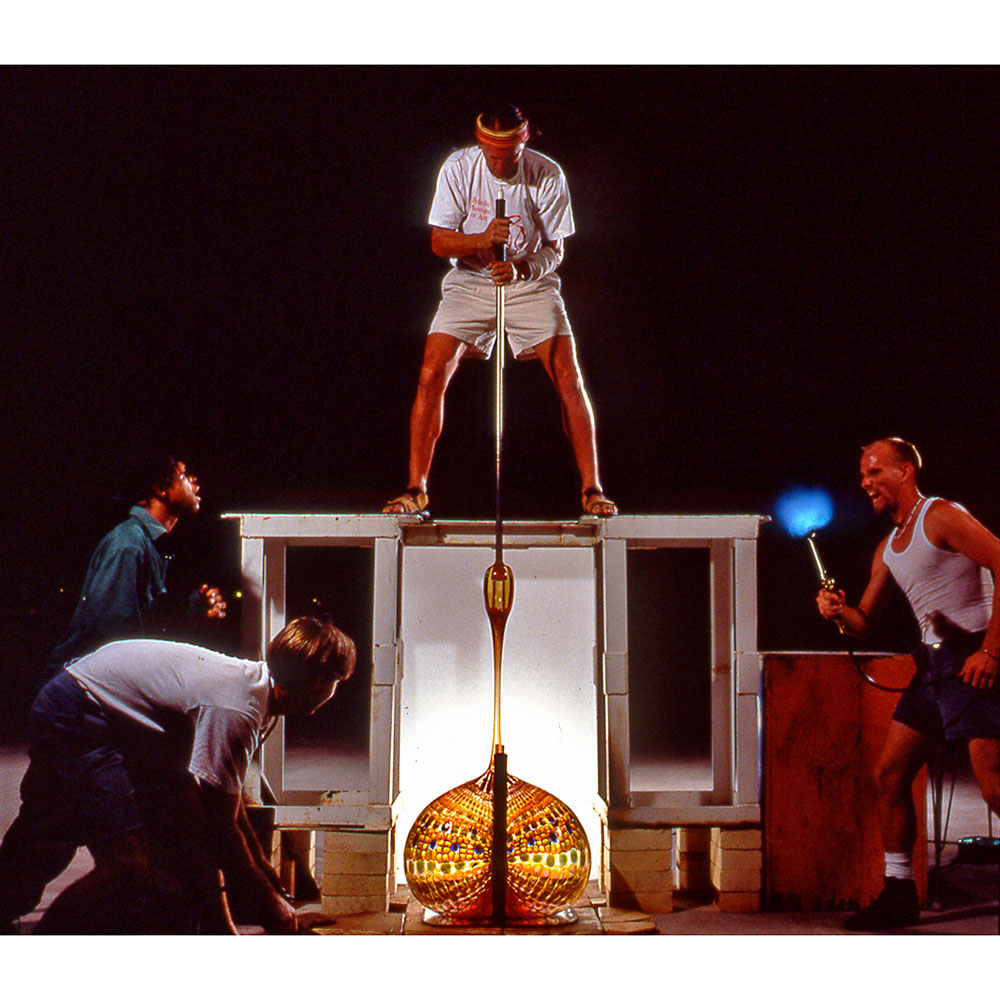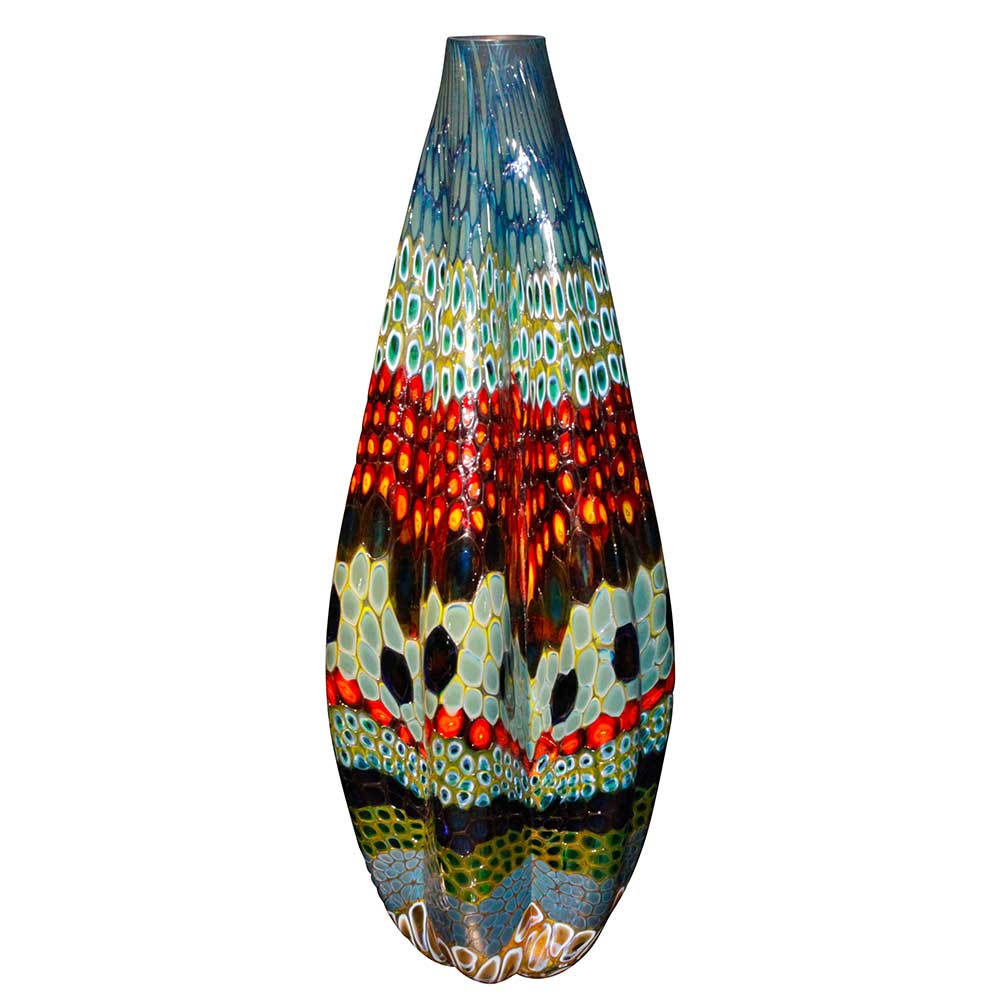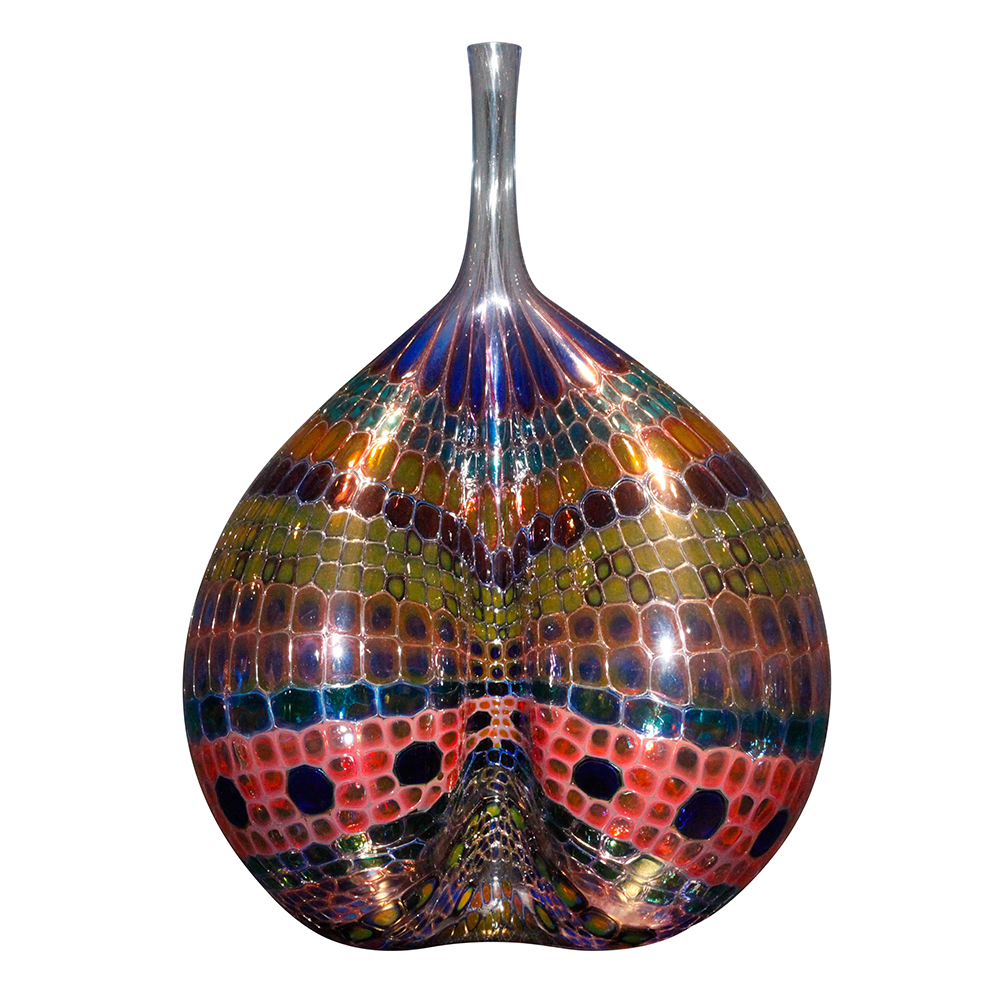By Louise Irvine
Dale Chihuly is arguably the most famous glass artist in the world. His name draws vast crowds to site-specific glass installations across the globe as well as to art galleries and museums internationally. The stunning Art on Fire exhibit at the Wiener Museum of Decorative Arts presents the creative exuberance of Chihuly’s glass art.
A fabulous Macchia garden seems to burst into bloom along with monumental Ikebana flower arrangements. A Persian wall is accompanied by Chihuly’s paintings for the original installation. Chihuly’s luminous Baskets and sensual Seaforms vie for attention with his flamboyant Venetians. A Chihuly Venetian was once described as a vase which has had an affair with a chandelier. Decide for yourself at WMODA!
Chihuly is the most innovative and influential glass artist of modern times, thanks to his teaching, teamwork, and artistic collaborations. Many of his friends, followers and mentors are represented at WMODA including Toots Zynsky, William Morris, Lino Tagliapietra and Pino Signoretto. Visit the Art on Fire exhibit at WMODA and discover how these hot glass artists are all connected to Chihuly and how his favorite cities, Venice and Seattle, are fused together through a passion for glass.
Fused together through a passion for glass…
Dale Chihuly was born in Tacoma, Washington in 1941 and first learned to melt and fuse glass in 1961 as he experimented in his home studio. He discovered glassblowing four years later and enrolled in the first glass program in the country at the University of Wisconsin-Madison. His graduate studies continued at the Rhode Island School of Design and then, with the award of a Fulbright Fellowship in 1968, he studied at the Venini glass studio in Italy. Chihuly was the first American glassblower to apprentice with the famed Murano masters and he brought many of the techniques that he learned in Venice back to the US. Foremost among these was the collaborative team approach to glass blowing which he taught at his RISD glass program for more than ten years. When Chihuly held his first Pilchuck summer school in Washington State in 1971, he started a movement in Seattle and Venice which fused them together through a passion for glass.
Hot glass slipped through the air, pulled and stretched…
One of Chihuly’s early students at RISD was Toots Zynsky. In Chihuly’s words, her class had extraordinary energy, amounting to “the most creative, highly charged institutional experience I’d ever been a part of.” Zynsky remembers, “Hot glass slipped through the air, pulled and stretched. There was music and the furnaces were roaring. . . and everyone was working in concert. . . It was this material that hadn’t been widely explored as an artist’s medium. Everything was possible, and there was so much to be discovered. There were no rules. You could do anything you wanted.”
In 1971, Zynsky was one of the artists invited by Chihuly to his summer school and she was involved in the development of the Pilchuck Glass School. Her early focus was slumped plate glass and she experimented with video and performance works using glass to explore issues in contemporary art. In 1980, Zynsky became head of the hot shop now known as Urban Glass in Brooklyn. A few years later she was invited to design for the Venini glassworks on Murano and she spent many years working in Europe. Today, Toots Zynsky is best known for her distinctive kiln formed glass thread vessels, which interweave the traditions of painting, sculpture and the decorative arts. Music is also an inspiration for Toots and in her words, “When I hear music, it translates into color.” WMODA has some particularly beautiful examples of her work.
Glassblowing is the closest thing to alchemy that I know…
Another remarkable glass artist to come under the spell of Chihuly was William Morris. Having studied in California and Washington, Morris found work as a driver at the Pilchuck Glass School in 1978. He began glass blowing with Chihuly and eventually became his chief gaffer, working with him for over 10 years. Together they created the iconic Macchia series, which used every color in the hot shop. Eventually, Morris set up his own studio to develop his personal artistic style, which reflected his spiritual interests in human origins, myth, ancestry, and ancient civilizations. For over 25 years, Morris honed his skills and created hauntingly evocative and beautiful glass sculptures before retiring in 2007. The Wiener Museum has some very fine examples of his early work which are reminiscent of prehistoric cave paintings and ancient standing stones. In his own words, “Glassblowing is the closest thing to alchemy that I know.”
He was such a whirlwind of energy and excitement and enthusiasm, he was like a magnet…
Chihuly is also fascinated with Native American artifacts, which can be seen in his glass art, together with his love of the Pacific Northwest, where his studio is based. The Baskets, one of his first glass series in 1977, was inspired by the slumped forms of woven native baskets and he often incorporated colored threads of glass in patterns derived from the wool blankets which he collects. His Seaforms were inspired by his love of the ocean and the colors in his Macchia designs evoke memories of his mother’s flower garden. Arthur Wiener’s impressive Macchia collection was the centerpiece of the Smithsonian National Building Museum in Washington to honor Chihuly when he received the 2016 Visionary Award from the Smithsonian Craft Show.
The largest Chihuly installation at WMODA is a magnificent Persian wall designed originally for Wolfgang Puck’s Postrio restaurant in San Francisco, together with two dramatic paintings. Ever since Chihuly’s accidents in the mid-1970s, which prevented him from blowing glass himself, painting has been an important form of creative expression and a way to communicate the concepts he wants to explore in glass to his studio assistants. He directs his gaffers and glass blowers, more like a choreographer than a dancer, more like a director than an actor.
Making art in a crowd with a crowd has always been the Chihuly way. As Benjamin Moore, one of his former gaffers explained, “He was such a whirlwind of energy and excitement and enthusiasm, he was like a magnet, drawing the most talented young people around him just to be in his presence to learn.” On a visit to Venice, Moore invited Maestro Lino Tagliapietra to give a demonstration at Pilchuck in 1979 and so the fruitful collaboration and friendship between Chihuly and the Italian masters extended to his team.
The greatest glassblower in the world…
When Lino Tagliapietra first visited Seattle, he didn’t speak a word of English but he certainly communicated with his exceptional command of glass. He recalls his first visit to Pilchuck “The technique, they were very poor, but the energy, they were fantastic.” He returned to teach many times during the years and the relationship proved to be mutually beneficial. Tagliapietra gained new perspectives on glass art from Chihuly and his team. In exchange, he taught the closely guarded Venetian secrets to aspiring American glass artists. In 1988, Chihuly asked Tagliapietra to collaborate on an audacious new series called the Venetians inspired by Murano glass from the Art Deco era. They added spiraling ribbons, feathers, leaves and flames of glass in vibrant colors to traditional vessels.
Lino began his glass career at the age of 12 and earned the rank of maestro when he was 25. He moved from commercial glass manufacture in Murano to creating his own studio glass during the 1980s. He had his first solo show in Seattle in 1990 and later opened a second studio in the heart of this city. Lino continues to combine modern experimentation with traditional Italian tricks as can be seen in his independent work at WMODA, including his iconic Saturno which became his personal emblem. Chihuly acclaims him as "the greatest glassblower in the world."
I was born like this, I eat, I drink, I live glass…
Chihuly also regards the late Pino Signoretto as “one of my best friends and one of the greatest glass sculptors of our time. He made extraordinary pieces and his skill and deep generosity of spirit helped not only me, but hundreds of other artists realize their creative vision.” The precocious young Signoretto began making chandeliers in Murano at the age of 10 and earned the title of maestro when he was 16. I was born like this,” Signoretto once said. “I eat, I drink, I live glass.”
Signoretto’s incredible facility in sculpting hot glass was renowned around the world and he collaborated with many artists at his own studio in Murano which he opened in 1978. Signoretto was a regular guest artist at Pilchuck where he shared his unique skills. He specialized in sculpting sea life which he often combined with impish putti on the monumental vessels that he made with Chihuly. In one spontaneous yet intense collaboration at Chihuly’s hotshop, there were 14 talented team members working together to release the artistic potential of the glass.
Pino said, “to make the magic happen you need four ingredients: sand, water, air and fire, to which I would add a fifth element which is the physical energy which the artist needs to use to shape glass.” Certainly, Chihuly and his collaborators have pushed the sculptural potential of glass and redefined the vocabulary of glass as an art form.
If I were known for anything, I would hope it would be for the color…
The Venetian connection continues to thrive in American glass art thanks to Lino Tagliapietra, who has received numerous awards for his teaching as well as honorary degrees, notably from Centre College in Danville, Kentucky where he was recently presented with the keys to the city. The glass program and state-of-the-art studio at Centre College was founded in 1985 by Stephen Rolfe Powell, also an acclaimed artist and educator. Powell studied ceramics before discovering hot glass which has become his full-time obsession. He creates monumental murrine glass vessels by standing on a platform and allowing gravity to assist with the blowing process. He is intrigued by irregular shapes in nature, which are swollen or puffed, including fruits and vegetables. Often his bold, textured organic forms are playful and whimsical. Color also inspires him, particularly sunrises and sunsets at his Kentucky home. Powell has presented workshops and exhibited his work and around the world, including Venice, and he invites many other illustrious glass artists to mentor his students in a shared passion for glass.
GLASS AND LIGHT GO HAND IN HAND, IT’S A MAGICAL MATERIAL
Rob Stern has worked with Dale Chihuly and his team on numerous occasions during his 30-year career as a glass-blower. He trained specifically with Pino Signoretto and was in his studio on the day that Pino began collaborating on the Venetian Putti series with Chihuly and Lino Tagliapietra.
Rob was born in Miami and grew up in Atlanta where he trained initially for a career in the performing arts. It was during his art studies at San Francisco State University that he discovered glass making. As he says, "When I started working with glass, I began to look at the world in a different way." Rob worked at an industrial glass casting facility for five years before attending the Pilchuck Glass School where he came under the spell of Chihuly, Pino and Lino. Now a successful master gaffer, Rob runs his own studio, Rob Stern Art Glass, in Wynwood, Miami where he relishes the Florida sunshine. In his view, “Glass and light go hand in hand, it’s a magical material.” Rob has exhibited his work widely and been invited to give demonstrations and workshops at Pilchuck and other famous glass institutions around the country as well International Symposiums, notably in the Czech Republic.
Read more about Chihuly...
Chihuly
Chihuly at the Smithsonian
Chihuly’s Poetic Persians
Chihuly - Rainbow Glass
Read more about Stephen Rolfe Powell...
Read more about William Morris...
William Morris - Petroglyphs in glass
Read more about Toots Zynsky...
Read more about Lino Tagliapietra...
Read more about Rob Stern
Rob Stern - Start is Born
Rob Stern - Art on fire the Chihuly connection
Rob Stern - Star of Wonder
Rob Stern - Who's who @ WMODA
Rob Stern - Constellations Exhibit
Rob Stern - Stilettos Exhibition
Rob Stern - Strut into WMODA
Rob Stern - Our New Hot Dog
Rob Stern - Stilettos
Rob Stern - Believe the Impossible
Rob Stern - Resonance WMODA

